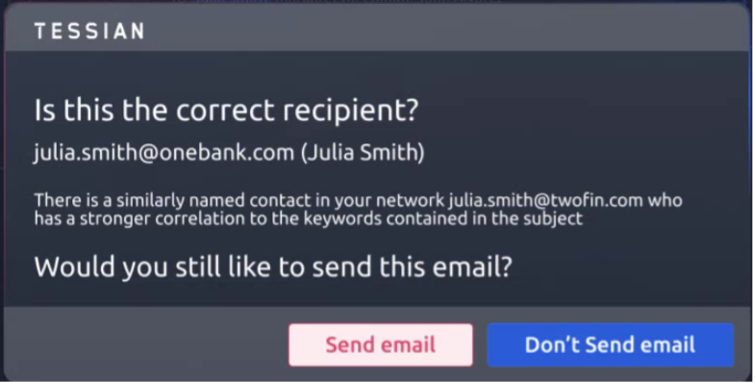Sensitive data loss has long been an issue for organizations of all sizes, leaving them exposed to compliance and reputation risks. From phishing and ransomware to advanced threats, there is a long and growing list of ways that sensitive information can find itself outside your defenses.
That said, it never really “finds itself” there. It ends up there incidentally, or intentionally—and usually, by employees. So much so that two-thirds of chief information security officers (CISOs) surveyed for our 2024 State of the Phish report said their business has experienced data loss due to an insider.
Once again, there are many ways this can happen. Even today’s most security-oblivious users likely understand that weak passwords and errant clicks or downloads pose a risk. However, another prevalent factor behind data loss does not garner the same level of focus.
It may surprise many to learn that misdirected emails—legitimate messages sent to incorrect recipients—are the number one General Data Protection Regulation (GDPR)-related cyber incident reported to the U.K.’s Information Commissioner’s Office (ICO).
Misdirected email happens all the time—and it’s difficult to stop with traditional tools. These errors are not usually flagged by standard rule-based data loss prevention (DLP) products. That leaves users solely responsible for ensuring that their emails are always sent to the intended recipients. Unfortunately, this human line of defense is not fully equipped for the task.
Why doesn’t traditional DLP solve misdelivery?
Traditional rule based DLP tools do what they do very well. Such tools remain a critical part of any effective cyber defense when it comes to protecting sensitive data. However, they have a major shortcoming in that they only check messaging against predefined risks.
Traditional DLP can identify whether:
- Recipients are on deny lists
- The content contains Social Security numbers or patient identifiers (RegEx patterns)
- Attached documents have classification tags; for example, if an admin has tagged a document as “sensitive”
Assuming your email passes these checks, it is deemed safe to send.
A misdirected email to a legitimate (albeit incorrect) recipient would not raise any red flags. A rule-based system would determine that this type of email is good to go. But based on Verizon’s Data Breach Investigations Report (DBIR) data, which shows that email misdelivery is prevalent across all industries, we know that it’s not.
An adaptive, artificial intelligence (AI)-powered DLP solution goes much further. It doesn’t just look for common predefined risks. Rather, it analyzes all aspects of an email for anything that looks anomalous.
So, on top of checking for common red flags, it can detect abnormal groupings of recipients and flag sensitive words, phrases or content that are not ordinarily shared with the intended recipients—whether in the body of the message or in any attachments. The solution will then determine whether an email is safe to send.

Overview showing how Tessian automatically detects what rule-based DLP misses.
Should it detect a potential mistake or sensitive data loss incident, Proofpoint Adaptive Email DLP will intervene to question the accuracy of the recipient, offer a brief explanation of the potential issue and ask whether the sender wishes to proceed or cancel.

Error message: Is this the correct recipient message?
Put simply, traditional DLP cannot stop incidents like these because they can’t be predefined. But Adaptive Email DLP can avert potential disasters in real time with simple, on-screen prompts for users so that they can correct any mistakes.
With a complete timeline of each incident—what was being sent, who it was being sent to and why it was stopped—security teams get actionable insight into common mistakes and intentional attempts to misdirect company data to personal or unauthorized accounts.
Advanced protection that puts people first
The power of Adaptive Email DLP is not only in how effectively it can stop data loss. It is also designed to fit in effortlessly with the way we already work. There are no additional steps to remember or changes to existing processes for end users.
People compose and send messages in the same way they always do. Our solution works in the background to determine whether emails are safe to send—and only intervenes if there is a potential problem.
This means end users only interact with the solution every few weeks rather than a few times a day. That helps to significantly reduce the risk of warning fatigue, an issue that can lead to a continued stream of data loss incidents.
Adoption is fast, too. There are no rules to implement and refine over time to balance security and user convenience—it is 100% automated. In most cases, Adaptive Email DLP is deployed in minutes, learns from historical messaging within hours, and is ready to protect your people and your data within days. But you don’t have to take our word for it—our customers agree.
Our solution recently prevented a merger and acquisition-related email from being sent to a journalist:
“We saw ROI in just one misdirected email prevented by Adaptive Email DLP.”
— General counsel, global law firm
Adaptive email DLP intervenes in the case of malicious insiders as well. Our solution helped a global financial institution spot and block attempts by a departing chief financial officer to send board meeting minutes and sensitive documents to a personal account.
“The platform is resonating—changing behavior and decreasing our level of risk.”
— CISO, global financial institution
Proofpoint Adaptive Email DLP
Adaptive Email DLP can help your business stop data loss by prompting users to correct the mistakes that lead to misdirected emails. Plus, it can automatically block attempts to send sensitive information to unauthorized recipients.
Harness the power of behavioral AI to prevent accidental and intentional data loss over email, reducing risk and remediation costs. Find out more about DLP solutions.
Learn from our experts
Have you ever sent an email to the wrong person? What about sending an email with the wrong attachment? What visibility do you have into these potential costly mistakes at your organization?
Watch our webinar about using AI to stop email misdelivery.

